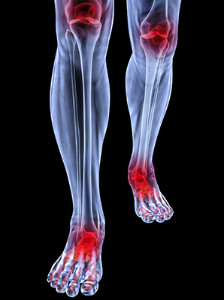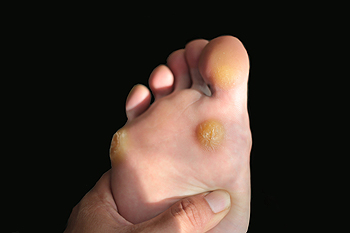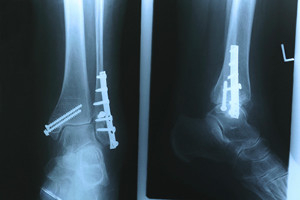
 A disease involving the immune system in which the joints are inflamed is rheumatoid arthritis. Standing and walking may often become difficult, as these movements involve use of the joints. Recent research has shown that common treatments for this condition may include anti-inflammatory drugs or surgery if no other option is available. Occasionally the feet may produce symptoms indicative of rheumatoid arthritis, such as stiffness and pain in the that spreads throughout the foot. It has been shown that there may be a link between higher body weight and this particular form of arthritis developing faster than other forms. Certain remedies may bring comfort, including choosing shoes that have proper arch support. Stretching may be another option, possibly relieving pain and providing joint mobility. Consult with your podiatrist for a proper diagnosis and treatment if you think have symptoms of rheumatoid arthritis.
A disease involving the immune system in which the joints are inflamed is rheumatoid arthritis. Standing and walking may often become difficult, as these movements involve use of the joints. Recent research has shown that common treatments for this condition may include anti-inflammatory drugs or surgery if no other option is available. Occasionally the feet may produce symptoms indicative of rheumatoid arthritis, such as stiffness and pain in the that spreads throughout the foot. It has been shown that there may be a link between higher body weight and this particular form of arthritis developing faster than other forms. Certain remedies may bring comfort, including choosing shoes that have proper arch support. Stretching may be another option, possibly relieving pain and providing joint mobility. Consult with your podiatrist for a proper diagnosis and treatment if you think have symptoms of rheumatoid arthritis.
Because RA affects more than just your joints, including the joints in your feet, it is important to seek early diagnosis from your podiatrist if you feel like the pain in your feet might be caused by RA. For more information, contact Dr. Robert Hope of Riverside Podiatry. Our doctor will assist you with all of your podiatric concerns.
What Is Rheumatoid Arthritis?
Rheumatoid Arthritis (RA) is an autoimmune disorder in which the body’s own immune system attacks the membranes surrounding the joints. Inflammation of the lining and eventually the destruction of the joint’s cartilage and bone occur, causing severe pain and immobility.
Rheumatoid Arthritis of the Feet
Although RA usually attacks multiple bones and joints throughout the entire body, almost 90 percent of cases result in pain in the foot or area.
Symptoms
Diagnosis
Quick diagnosis of RA in the feet is important so that the podiatrist can treat the area effectively. Your doctor will ask you about your medical history, occupation, and lifestyle to determine the origin of the condition. Rheumatoid Factor tests help to determine if someone is affected by the disease.
If you have any questions please feel free to contact our office located in Tuscaloosa, and Fayette, AL . We offer the newest diagnostic and treatment technologies for all your foot needs.
Read more about Rheumatoid Arthritis in the Feet Corns and calluses are areas where the skin has hardened, generally due to friction and pressure. This friction usually stems from footwear and socks; to help prevent them from forming, wear shoes that have enough room for your feet and aren’t cramped. Over-the-counter chemical peels can remove either corns or calluses at the risk of potentially damaging skin. Pumice stones can be used to remove corns and calluses but can also damage skin. If you are a diabetic, do not attempt to remove either one and instead see a podiatrist. Overall, podiatrists can treat corns and calluses in ways that do not risk harm to your feet.
Corns and calluses are areas where the skin has hardened, generally due to friction and pressure. This friction usually stems from footwear and socks; to help prevent them from forming, wear shoes that have enough room for your feet and aren’t cramped. Over-the-counter chemical peels can remove either corns or calluses at the risk of potentially damaging skin. Pumice stones can be used to remove corns and calluses but can also damage skin. If you are a diabetic, do not attempt to remove either one and instead see a podiatrist. Overall, podiatrists can treat corns and calluses in ways that do not risk harm to your feet.
If you have any concerns regarding your feet and ankles, contact Dr. Robert Hope of Riverside Podiatry. Our doctor will treat your foot and ankle needs.
Corns: What Are They? and How Do You Get Rid of Them?
Corns can be described as areas of the skin that have thickened to the point of becoming painful or irritating. They are often layers and layers of the skin that have become dry and rough, and are normally smaller than calluses.
Ways to Prevent Corns
There are many ways to get rid of painful corns such as wearing:
Treating Corns
Treatment of corns involves removing the dead skin that has built up in the specific area of the foot. Consult with Our doctor to determine the best treatment option for your case of corns.
If you have any questions please feel free to contact our office located in Tuscaloosa, and Fayette, AL . We offer the newest diagnostic and treatment technologies for all your foot and ankle needs.
 When it comes to buying shoes, it’s important to buy footwear that is suitable for what you will be doing. If you plan on running, try to find footwear that is breathable, flexible, supportive, and comfortable. While you should look for these traits in all footwear, different environments require different features. Hiking, for example, requires a more rigid shoe that may not be as breathable, especially if they are designed for cold weather environments. Walking, on the other hand, can be performed in running shoes that are comfortable and well-fitted. If you go rock climbing, then rock climbing shoes are essential as they have superior gripping to help prevent falls. However, rock climbing shoes are not very supportive and are meant to be tight around the feet. These attributes make them unsuitable for everyday wear. Wearing the right type of shoes is vital to preventing foot injuries and will allow you to more safely enjoy all your favorite outdoor activities.
When it comes to buying shoes, it’s important to buy footwear that is suitable for what you will be doing. If you plan on running, try to find footwear that is breathable, flexible, supportive, and comfortable. While you should look for these traits in all footwear, different environments require different features. Hiking, for example, requires a more rigid shoe that may not be as breathable, especially if they are designed for cold weather environments. Walking, on the other hand, can be performed in running shoes that are comfortable and well-fitted. If you go rock climbing, then rock climbing shoes are essential as they have superior gripping to help prevent falls. However, rock climbing shoes are not very supportive and are meant to be tight around the feet. These attributes make them unsuitable for everyday wear. Wearing the right type of shoes is vital to preventing foot injuries and will allow you to more safely enjoy all your favorite outdoor activities.
If you are a runner, wearing the right running shoe is essential. For more information, contact Dr. Robert Hope from Riverside Podiatry. Our doctor can provide the care you need to keep you pain-free and on your feet.
Choosing the Right Running Shoe for Your Foot Type
To increase performance and avoid the risk of injury, it is important to choose the right running shoe based on your foot type. The general design of running shoes revolves around pronation, which is how the ankle rolls from outside to inside when the foot strikes the ground.
If you have any questions please feel free to contact our office located in Tuscaloosa, and Fayette, AL . We offer the newest diagnostic and treatment technologies for all your foot and ankle needs.
 When is comes to podiatric care, podiatrists strive to exhaust all nonsurgical treatment options first. However, there are times and many reasons why people may need foot surgery. Some of these include bunions, which are bony bumps that form on the base of big toe. Surgery may involve straightening the big toe if symptoms continue for a long period of time. Permanently bent toes, also called hammertoes, can be eased by removing the deformed joint between the toes, which improves flexibility. Rheumatoid arthritis can leave the joints in the foot damaged by inflammation. The exact procedure will depend on the severity of this condition, but surgery is commonly performed on the big toe in order to make walking easier. If the is damaged, fusion may be necessary to fuse the talus bone to the tibia, thereby relieving pain in the . Screws are used to hold the bones together, and will heal for 12-14 weeks. Normal shoes can be worn soon afterward and it will be easier to walk. Please consult with a podiatrist to discuss all options when it comes to foot-related conditions.
When is comes to podiatric care, podiatrists strive to exhaust all nonsurgical treatment options first. However, there are times and many reasons why people may need foot surgery. Some of these include bunions, which are bony bumps that form on the base of big toe. Surgery may involve straightening the big toe if symptoms continue for a long period of time. Permanently bent toes, also called hammertoes, can be eased by removing the deformed joint between the toes, which improves flexibility. Rheumatoid arthritis can leave the joints in the foot damaged by inflammation. The exact procedure will depend on the severity of this condition, but surgery is commonly performed on the big toe in order to make walking easier. If the is damaged, fusion may be necessary to fuse the talus bone to the tibia, thereby relieving pain in the . Screws are used to hold the bones together, and will heal for 12-14 weeks. Normal shoes can be worn soon afterward and it will be easier to walk. Please consult with a podiatrist to discuss all options when it comes to foot-related conditions.
Foot surgery is sometimes necessary to treat a foot ailment. To learn more, contact Dr. Robert Hope of Riverside Podiatry. Our doctor will assist you with all of your foot needs.
When Is Surgery Necessary?
foot surgery is generally reserved for cases in which less invasive, conservative procedures have failed to alleviate the problem. Some of the cases in which surgery may be necessary include:
What Types of Surgery Are There?
The type of surgery you receive will depend on the nature of the problem you have. Some of the possible surgeries include:
Benefits of Surgery
Although surgery is usually a last resort, it can provide more complete pain relief compared to non-surgical methods and may allow you to finally resume full activity.
Surgical techniques have also become increasingly sophisticated. Techniques like endoscopic surgery allow for smaller incisions and faster recovery times.
If you have any questions please feel free to contact our office located in Tuscaloosa, and Fayette, AL . We offer the newest diagnostic and treatment technologies for all your foot needs.
Read more about Foot Surgery